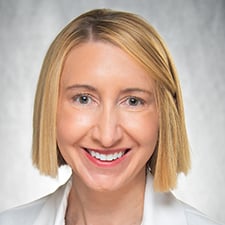For Lyndsay Harshman, MD, a satisfying career in medicine includes a strategic balance between research and clinical care.
“To be successful, you can’t really have one without the other,” she said. “You have to see the clinical conundrums in order to ask the questions that drive research.”
As a pediatric nephrologist at University of Iowa Health Care, Dr. Harshman happily wears these two hats: one as a leading researcher in the field and one as a physician who expertly cares for her young patients and their families.
University of Iowa Health Care is a member of the AMA Health System Program, which provides enterprise solutions to equip leadership, physicians and care teams with resources to help drive the future of medicine.
But when Dr. Harshman was in medical school, it took her some time to find a specialty that allowed her to find this balance.
“My husband likes to joke that before coming into my clinical rotation, I had picked every specialty in the book, except for pediatrics!” she explained.
In fact, between her second and third year of medical school, Dr. Harshman spent a research year working with older adults who had cancer and studying the impact of chemotherapy on the brain. Dr. Harshman came back to her M3 year planning to go into adult oncology.
However, during her first clinical rotation in pediatrics, she started to envision a different path.
“I loved kids, and I loved the nature of pediatrics,” Dr. Harshman said. “To some extent, kids are an open box. And the way pediatric patients present can be a mystery, so that really appealed to my detective work niche.”
But she wasn’t all in on pediatrics until she met pediatric nephrologist Patrick Brophy, MD, a faculty member who was on call during her rotation.
“Pat was tremendous with his love for the patients he cared for, his love for the trainees and his love for medicine,” said Dr. Harshman. “Working with him was one of those experiences where I realized, I want to be that person, and I want to do what he’s doing.”
With Dr. Brophy as a role model, Dr. Harshman started uncovering her own passion for the field of pediatric nephrology.
“I enjoyed the relationships I saw the team have with their patients, the complexity of care, the ability to think creatively while still embracing the physiology. All of that represented pediatric nephrology—and I knew it was the right fit for me,” she said.
In an interview with the AMA, Dr. Harshman discusses the collaborative spirit of pediatric nephrology, how the field has evolved and the research she’s leading as part of the Stead Family Scholars Program at University of Iowa Health Care.
AMA: How did you realize pediatric nephrology was the right fit for you?
Dr. Harshman: I saw the depth that nephrology encompasses, including cardiovascular disease, autoimmune disease, immunology, transplantation, surgery and more. It became really apparent to me that this was an opportunity to use my skills to the fullest to provide excellent patient care.
After doing an advanced student elective with the pediatric nephrology team in my M4 year, I was like, sign me up! This is what I want to do.
Dr. Brophy had this saying, ’It’s all part of the cosmic debris.’ And that is something I’ve really come to embrace. I realized that when opportunities come up, you have to be willing to just take the dive … and see where the road takes you. Now, many years later, I am in a career where I get to do so many amazing things. It’s complex, hard and fun.
AMA: How do you work with other specialists to address different health challenges your pediatric nephrology patients face?
Dr. Harshman: Our interdisciplinary teams embody the family approach that you see so often in pediatrics. Every discipline serves a different member of the family. At the end of the day, having a full family unit to take care of a child is absolutely required to get them successfully to the next phase in life.
For example, babies who are born with severe kidney issues often have significant pulmonary hypertension. So, I have close relationships with my cardiology colleagues. In fact, we may have a patient who needs significant cardiac support to be able to get to transplant. Or maybe we need to discuss a dual organ transplant—a heart and a kidney transplant. Those are exceptionally collaborative discussions because without one team, the other team's mission falls apart.
Having these tremendous relationships between specialties here at University of Iowa really allows us to get these very challenging little kids successfully to transplant.
AMA: How has the field of pediatric nephrology advanced since you first started?
Dr. Harshman: The biggest advancement or change in pediatric nephrology since I finished my fellowship in 2016 is our ability to provide dialysis to tiny babies has improved. People really pushed for better devices in our field, and we have more options for neonates than we did 10 years ago.
Until the last few years, centers had to utilize machines and dialysis filters—designed for adults!—for neonates and young children. Using a larger dialysis filter meant using larger tubing and a larger dialysis catheter, which could be extremely technically challenging to place in a tiny infant. But now, there are smaller machines, smaller filters and smaller dialysis catheters. This allows us options to provide dialysis therapy to babies who otherwise may not have had a viable dialysis therapy.
This has been particularly beneficial for babies who are born with significant early life renal disease—for example, renal dysplasia or agenesis—where their kidneys don’t form appropriately. Babies with these conditions can be very challenging to dialyze early on. But these advances open up a therapeutic bridge to get these babies out of the hospital and eventually to kidney transplant.
AMA: How do you see the role of technology evolving in pediatric nephrology?
Dr. Harshman: Technologies such as remote patient monitoring are starting to become more common place in medicine. These remote patient monitoring technologies and app-based technology can be really helpful for patients who live further from medical care and to help optimize adherence to medical therapies. However, it can be hard because the remote patient monitoring needs for adults are a little bit different than young adults or preteens. For our pediatric patients, we need something that will get them to buy in and use the technology.
Some of our teenage patients have found apps that sync to Bluetooth water bottles to help remind them to drink more water. For example, when one of our teenagers was in clinic with us the other day, she told us, ‘Oh dear, my phone is at it again.’ It was the app on her phone sending her messages that her kidneys were getting dry and reminding her to drink. She may roll her eyes at it, but it clearly got her attention.
AMA: What are some of the biggest challenges in pediatric nephrology today?
Dr. Harshman: Pediatrics in general is challenged by the fact that many of our chronic diseases, such as chronic kidney disease, are still relatively rare but are present for the individual patient’s entire lifespan. It’s important for us to continue raising awareness that our kids with chronic kidney disease face a lifetime of illness and a lifetime of medical comorbidities. It doesn't just go away.
One of the biggest challenges with this is successfully transitioning our patients into the adult care model. I would love to see a better approach to how we transition children into adult care models to optimize their health and independence. We in pediatrics can help by forming relationships with our adult colleagues and continuing to advocate at the national and statewide level for the resources and care models that will help our patients.
AMA: What is involved in the research side of your career as part of the Stead Family Scholar Program?
Dr. Harshman: The Stead Family Scholar Program represents an extremely generous philanthropic donation from the Stead family to support a researcher being able to take the next steps in their research career. I'm in that early- to mid-career phase where I've had an RO1 grant that looks at the impact of chronic kidney disease on brain development and thinking processes.
AMA: What connection have you found between kidney disease and brain development through your research?
Dr. Harshman: We have some novel findings … that show how lower kidney function seems to impact the amount of gray matter volume in the cerebellum of the brain. Interestingly, that gray matter volumetric reduction in the cerebellum seems to predict challenges with executive functioning, such as planning, decision-making and attention functionalities of our cognition day-to-day.
Before our team had discovered this, none of this had ever been reported before. So, we have this robust data, and we've done all this work in humans with kids and young adults 6 to 21 years old. The challenge is that we have observational data, but we don't have a good mechanism for why we see what we see.
AMA: How will being part of the Stead Family Scholar Program help you take the next steps in this research?
Dr. Harshman: Over half of kids with chronic kidney disease have chronic kidney disease due to congenital kidney anomalies. But because it’s congenital, it's reasonable to speculate maybe that same developmental anomaly that impacted kidney disease could have also impacted their brain development.
To disentangle that, we're trying to pivot into an animal model of a kidney disease that is similar to our pediatric patients. This will allow us to better answer: Is chronic kidney disease impacting the brain? Or is kidney development an underlying developmental predisposition that's impacting the brain? Or is it both?
The Stead Family Scholars award has allowed me to take a huge pivot with my career and start diving into these basic science ideas, hypotheses and experiments. Without this type of generous philanthropic support, I couldn't have done such a big pivot at this point in my career.





